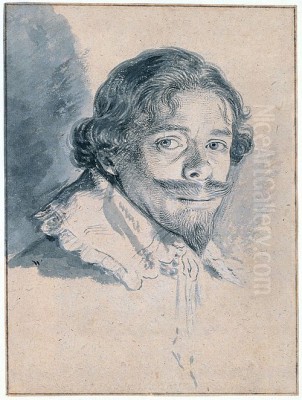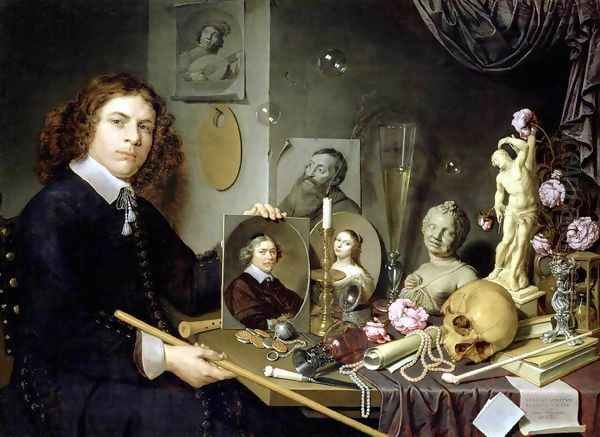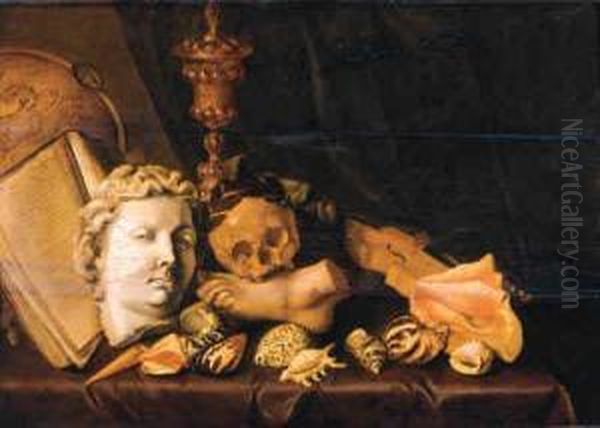
David Bailly (1584-1657) stands as a significant, if sometimes overlooked, figure in the rich tapestry of Dutch Golden Age painting. Born and primarily active in the vibrant university city of Leiden, Bailly carved a distinct niche for himself, particularly through his evocative Vanitas still lifes and insightful portraits. His work not only reflects the artistic preoccupations of his time but also offers a deeply personal meditation on the transient nature of life, fame, and earthly possessions.
Early Life and Artistic Formation in Leiden
David Bailly was born in Leiden in 1584. His father, Pieter Bailly, was a Flemish immigrant, a calligrapher, and a fencing master, suggesting an environment where both intellectual and manual skills were valued. A more direct artistic influence came from his maternal grandfather, Jacques de Gheyn II (c. 1565-1629), a highly respected engraver, draftsman, and painter. De Gheyn II was a versatile artist known for his meticulous detail, his early forays into flower painting, and his allegorical works, including Vanitas themes. This familial connection undoubtedly provided young Bailly with early exposure to artistic techniques and concepts.
Bailly's formal artistic training began under his father's tutelage. He then apprenticed with the aforementioned Jacques de Gheyn II, whose refined draftsmanship and intellectual approach to art would have left a lasting impression. De Gheyn II himself had studied with the great Hendrik Goltzius, linking Bailly to a strong tradition of Netherlandish graphic arts. This foundation in drawing and engraving would become evident in the precision and clarity of Bailly's later painted works.
To further hone his skills, particularly in painting, Bailly moved to Amsterdam. There, he studied with Cornelis van der Voort (1576-1624), a prominent portrait painter. Van der Voort was known for his individual and group portraits of Amsterdam's regents and wealthy burghers, and his workshop would have provided Bailly with invaluable experience in capturing likenesses and conveying the status of his sitters. This period in Amsterdam exposed Bailly to a bustling art market and the prevailing trends in portraiture, which were increasingly in demand by the prosperous Dutch merchant class.
The Grand Tour and Broadening Horizons

Between 1608 and 1613, Bailly embarked on a "Grand Tour," a customary journey for aspiring artists and gentlemen of the era, intended to broaden their cultural and artistic education. His travels took him through Germany and, significantly, to Italy, including a stay in Venice. While specific details of his encounters in Italy are scarce, the experience would have exposed him to the masterpieces of the Italian Renaissance and the dramatic innovations of contemporary artists like Caravaggio and his followers, whose use of chiaroscuro was transforming European painting.
During these travels, Bailly reportedly gained the admiration of several European princes. Notably, the Duke of Brunswick (often anachronistically referred to as Burgundy in older sources, but more likely a German prince given his itinerary) was impressed enough to offer him a position. However, Bailly chose to decline this offer, a decision that underscores his attachment to his homeland and perhaps his desire to establish himself independently in the familiar artistic environment of Leiden. This period abroad, though, would have enriched his visual vocabulary and technical repertoire.
Return to Leiden: A Career in Portraiture and Still Life
Upon his return to Leiden around 1613, David Bailly established himself as an independent master. He quickly became a respected member of the city's artistic community. Leiden, with its prestigious university founded in 1575, was a major center of learning and Calvinist theology. This intellectual environment fostered a demand for portraits of professors, scholars, and students, a genre in which Bailly excelled. His portraits from this period are characterized by their sober realism, careful attention to detail in rendering faces and attire, and an ability to convey the sitter's intellectual gravitas.
Alongside his portraiture, Bailly dedicated himself to still life painting, with a particular emphasis on the Vanitas theme. The Vanitas, Latin for "vanity," refers to still lifes that use symbolic objects to remind the viewer of the transience of life, the futility of earthly pleasures, and the certainty of death. This genre was especially popular in Leiden, a city deeply imbued with Calvinist thought, which emphasized piety, introspection, and the ephemeral nature of worldly existence. Bailly became one of the foremost exponents of the Leiden Vanitas tradition.
His commitment to the artistic community of Leiden is further evidenced by his role in the local Guild of Saint Luke. He was one of the founders of the Leiden guild in 1648 and later served as its dean. The guilds played a crucial role in regulating the art trade, maintaining standards of craftsmanship, and providing a framework for the training of apprentices. Bailly's involvement highlights his standing among his peers.
The Essence of Vanitas: Bailly's Symbolic Language

David Bailly's Vanitas still lifes are complex allegories, meticulously composed and rich in symbolism. These paintings are not merely collections of objects but carefully constructed sermons in paint. Common motifs in his Vanitas works include skulls, the ultimate symbol of death (memento mori); extinguished or guttering candles and oil lamps, signifying the passage of time and the brevity of life; hourglasses or clocks, measuring life's fleeting moments; and soap bubbles (homo bulla – "man is a bubble"), representing the fragility and emptiness of human existence.
Musical instruments, like lutes or violins with broken strings, often appear, symbolizing the ephemeral nature of pleasure and harmony. Books and scientific instruments might allude to the vanity of human knowledge in the face of divine wisdom and mortality. Flowers, especially those past their prime or wilting, speak of beauty's decay. Wine glasses, empty or overturned, can refer to fleeting pleasures. Jewels, coins, and luxurious fabrics point to the worthlessness of earthly riches in the grand scheme of eternity.
Bailly's genius lay in his ability to arrange these objects in compositions that were both aesthetically pleasing and intellectually stimulating. His lighting is often subtle, creating a contemplative mood, and his rendering of textures – the cold smoothness of a skull, the delicate transparency of a glass, the soft petals of a flower – is masterly. These works invited viewers to reflect on their own lives and spiritual well-being. He was a contemporary of other still life painters who explored similar themes, such as Pieter Claesz (1597/98–1660) and Willem Claesz. Heda (1594–1680) in Haarlem, known for their "monochrome banketjes" (monochrome banquet pieces), which often carried subtle Vanitas connotations. In Utrecht, Ambrosius Bosschaert the Elder (1573-1621) and later Jan Davidsz. de Heem (1606-1684) created lavish floral still lifes that also spoke of transience.
Master of Portraiture: Capturing Likeness and Status
While his Vanitas paintings are perhaps his most distinctive contribution, David Bailly was also a highly accomplished portraitist. His training with Cornelis van der Voort in Amsterdam provided a solid foundation in this genre. Bailly's portraits are characterized by their psychological insight and meticulous rendering of detail, which appealed to the tastes of Leiden's academic and professional elite.

He painted numerous portraits of Leiden University professors, students, and other local dignitaries. These works often convey a sense of seriousness and intellectual depth, appropriate for their sitters. For instance, his drawing Portrait of a Man (1625), now often referred to as the Amsterdam Portrait, and another pen drawing, Leiden Portrait (1626), showcase his skill in capturing individual character with fine, controlled lines. While fewer of his painted portraits of specific, named individuals from this period are widely known compared to his Vanitas works, their existence is documented, and they formed a significant part of his oeuvre.
His approach to portraiture was less flamboyant than that of some of his contemporaries, such as Frans Hals (c. 1582/83–1666) in Haarlem, who was renowned for his lively brushwork and dynamic characterizations. Bailly's style was more aligned with the precise and detailed manner favored in Leiden, a precursor to the "fijnschilder" (fine painter) tradition later perfected by artists like Gerrit Dou (1613-1675), Rembrandt's first pupil in Leiden.
Key Works: A Closer Look
Among David Bailly's most celebrated works is his _Self-Portrait with Vanitas Symbols_ (1651), now in the Stedelijk Museum De Lakenhal, Leiden. This painting is a remarkable and complex piece, a culmination of his artistic concerns. In it, the aging artist presents himself holding a maulstick and a palette, looking out at the viewer. However, he also includes a portrait of his younger self, held by his own hand, alongside a plethora of Vanitas symbols: a skull, an extinguished candle, an hourglass, wilting flowers, a pearl necklace, coins, a pipe, a book, a sculpture, and even portraits of his deceased wife and perhaps other figures. The inscription "Vanitas Vanitatum et Omnia Vanitas" (Vanity of vanities, all is vanity) often appears in such works, or is implied. This painting is a profound meditation on time, mortality, and the enduring, yet ultimately vain, nature of artistic creation itself. The artist, even as he creates, acknowledges his own ephemerality.
Another significant work is _Vanitas Still Life with Portrait of a Young Painter_ (also dated 1651). This painting shares many thematic and compositional elements with the self-portrait. It features a young man, possibly one of Bailly's students or even another representation of his younger self, surrounded by an array of Vanitas objects. The inclusion of the painter's tools and a drawing or painting within the painting (a mise en abyme) further emphasizes the theme of art's relationship to life and death. These complex "meta-paintings" demonstrate Bailly's intellectual depth and his innovative approach to the Vanitas genre, merging it seamlessly with portraiture.
His earlier works, such as the aforementioned pen drawings like the Amsterdam Portrait (1625) and the Leiden Portrait (1626), reveal his exceptional skill as a draftsman. The Prince of Denmark Portrait, though less specifically documented in terms of current location or precise sitter identification in readily available sources, points to his reputation extending to patrons of high standing. These works, whether in oil or pen and ink, consistently display a high level of technical proficiency and thoughtful composition.
Artistic Technique and Style
David Bailly's artistic style is characterized by its meticulous detail, smooth finish, and careful rendering of light and texture. His early training as a draftsman under Jacques de Gheyn II is evident in the precise linearity of his work, especially in his drawings and the underpinnings of his paintings. He had a remarkable ability to differentiate between various materials – the gleam of metal, the transparency of glass, the softness of fabric, the coolness of marble, and the texture of human skin.
In his Vanitas still lifes, compositions are often carefully balanced, with objects arranged on a table or ledge, frequently draped with a rich cloth. The lighting is typically subdued, often emanating from a single source, creating subtle shadows and highlighting the symbolic objects. This controlled use of chiaroscuro enhances the contemplative and somber mood of his Vanitas pieces.
His color palette is generally restrained, favoring earthy tones, grays, and browns, punctuated by the occasional vibrant hue of a flower or a piece of fruit. This sobriety of color contributes to the serious intellectual and moral messages of his paintings. While not as overtly dramatic as the tenebrism of Caravaggio or the dynamic brushwork of Rembrandt van Rijn (1606-1669), who also spent his early formative years in Leiden, Bailly's technique was perfectly suited to his chosen themes, emphasizing clarity, precision, and intellectual engagement. His style shows an affinity with other Leiden artists who valued fine execution, such as Jan Lievens (1607-1674), a contemporary of Rembrandt in Leiden, and later, the "fijnschilders."
Influence, Teaching, and Contemporaries
David Bailly was an influential figure in the Leiden art scene. As a co-founder and dean of the Guild of Saint Luke, he played an active role in shaping the artistic environment of the city. He also took on pupils, passing on his skills and thematic concerns. Most notably, he taught his nephews, Harmen Steenwyck (c. 1612 – c. 1656) and Pieter Steenwyck (c. 1615 – c. 1660). Both Harmen and Pieter became accomplished painters specializing in Vanitas still lifes, clearly building upon the foundations laid by their uncle. Harmen Steenwyck, in particular, is celebrated for his refined and poignant Vanitas compositions.
Bailly's work existed within a vibrant artistic milieu. The Dutch Golden Age saw an explosion of artistic talent across various genres. In Leiden itself, besides the young Rembrandt and Lievens, artists like Jan van Goyen (1596-1656) were pioneering landscape painting. While Bailly's direct interactions with Rembrandt are not extensively documented, they were contemporaries in the same relatively small city for a period, and it's likely they were aware of each other's work. The intellectual climate of Leiden, with its university, also attracted scholars and thinkers, creating a sophisticated audience for art that engaged with philosophical and moral themes.
His interaction with Thomas de Keyser (c. 1596/97–1667) in Amsterdam, who painted Bailly's portrait, indicates his connections within the broader Dutch art world. De Keyser was a leading portraitist in Amsterdam before Rembrandt's rise to prominence there. Bailly's decision to specialize in Vanitas and portraits, and his meticulous style, set him apart, yet also placed him firmly within the traditions of Dutch Golden Age painting, which valued realism, craftsmanship, and often, moral instruction. One might also consider the broader context of still life painting, with artists like Clara Peeters (1594-c.1657), one of the few prominent female artists of the time, who excelled in detailed still lifes, or Adriaen Brouwer (1605/6-1638), whose genre scenes, though different in subject, shared a keen observation of everyday life and objects.
Later Years and Enduring Reputation
David Bailly continued to work in Leiden throughout his life. The creation of his complex self-portrait in 1651, when he was 67 years old, demonstrates his continued artistic vitality and intellectual engagement even in his later years. The provided information mentions that he had to rewrite his will in his later years due to health problems, suggesting he may have suffered from illness before his death.
He passed away in Leiden in 1657, at the age of 73, leaving behind a significant body of work that continues to be studied and admired. While perhaps not as universally famous as some of his Dutch contemporaries like Rembrandt, Vermeer, or Hals, David Bailly holds an important place in the history of Dutch art, particularly as a master of the Vanitas still life and a key figure in the Leiden school.
His unique fusion of self-portraiture with Vanitas elements represents a particularly personal and poignant exploration of these themes. Modern technical analysis of his paintings continues to reveal the sophistication of his techniques and the depth of his symbolism, reaffirming his status as a skilled and thoughtful artist. His works are held in major museum collections and offer a compelling window into the cultural and intellectual world of the Dutch Golden Age.
Conclusion: The Reflective Art of David Bailly
David Bailly was more than just a skilled painter; he was an artist-philosopher whose works invite contemplation on the most fundamental aspects of human existence. Through his meticulously rendered portraits, he captured the likenesses and characters of his contemporaries. In his evocative Vanitas still lifes, he masterfully employed a rich symbolic language to explore themes of time, mortality, and the ephemeral nature of worldly concerns. His legacy endures not only in his own paintings but also through the work of his students and his contribution to the artistic life of Leiden. As an art historian, one appreciates Bailly for his technical skill, his intellectual depth, and his profound ability to make a universal statement through the intimate medium of still life and portraiture, securing his place as a distinguished master of the Dutch Golden Age.